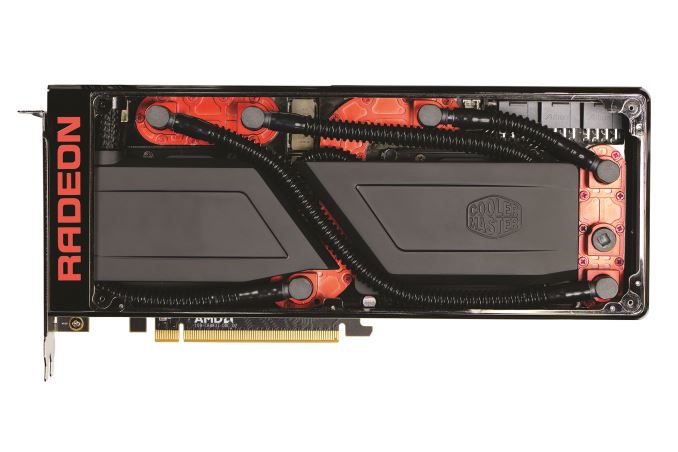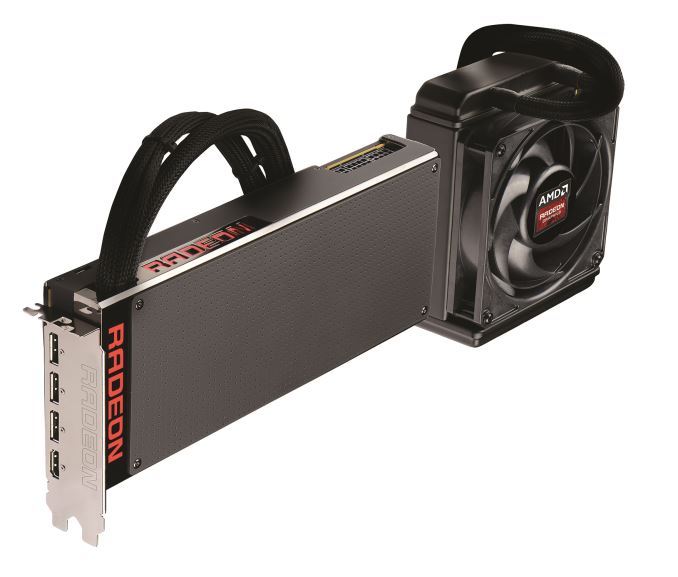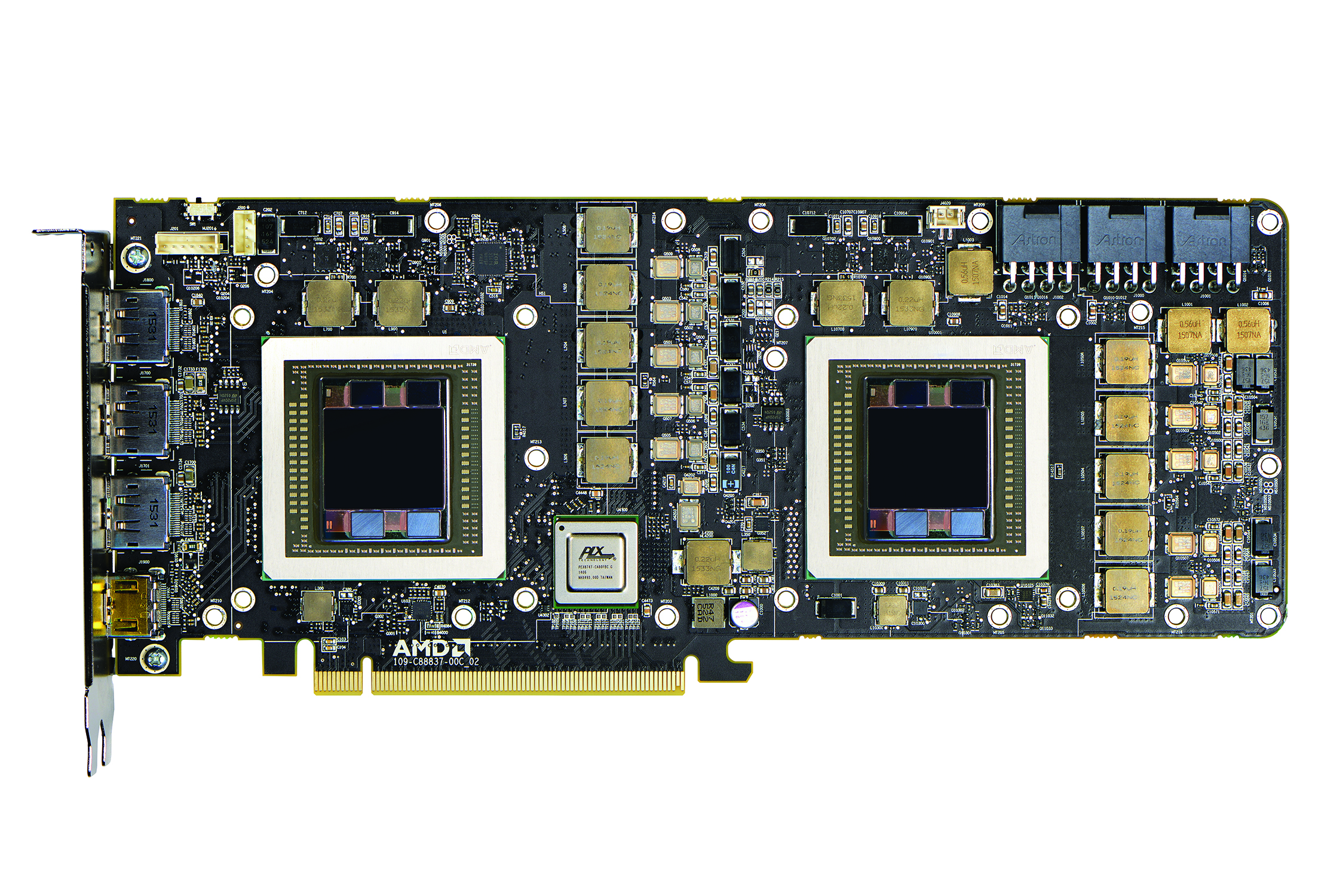AMD Releases Radeon Pro Duo: Dual Fiji, 350W, $1500
by Daniel Williams on April 26, 2016 9:00 AM EST
These recent years we have seen a slow but steady buildup of VR from both technological developments to growing enthusiasm shown by consumers and the industry. Today AMD is releasing the Radeon Pro Duo to the market as their first card targeted at VR developers. This card is not being directly aimed at gamers, despite the capability under the hood, but focuses on official support for professional software. Additionally, multiple initiatives are being both spearheaded and supported by AMD and others to encourage growth in the VR sector.
The AMD Radeon Pro Duo was first announced back in March, with the card is being marketed for VR content creation first and foremost. With this card, AMD is promoting the ability to allocate one GPU per eye while powering VR experiences. This way the case is opened up for performance beyond what any other single card can offer today. Another use case for developers is offloading compute work to the second GPU while the first is used for graphical work which can make for a much smoother experience during demanding a workflow.
Gaming is definitely possible on Radeon Pro Duo and alongside the FirePro drivers for content creators, Radeon drivers will be available. The Pro Duo will not see validation for as many applications as a true FirePro card, but official support will be provided for applications important to gaming content creation such as Autodesk, Maya, and Blackmagic Davinci Resolve.
| AMD GPU Specification Comparison | ||||||
| AMD Radeon Pro Duo | AMD Radeon R9 Fury X | AMD Radeon R9 Fury | AMD Radeon R9 295X2 | |||
| Stream Processors | 2 x 4096 | 4096 | 3584 | 2 x 2816 | ||
| Texture Units | 2 x 256 | 256 | 224 | 2 x 176 | ||
| ROPs | 2 x 64 | 64 | 64 | 2 x 64 | ||
| Boost Clock | 1000MHz | 1050MHz | 1000MHz | 1018MHz | ||
| Memory Clock | 1Gbps HBM | 1Gbps HBM | 1Gbps HBM | 5Gbps GDDR5 | ||
| Memory Bus Width | 2 x 4096-bit | 4096-bit | 4096-bit | 2 x 512-bit | ||
| VRAM | 2 x 4GB | 4GB | 4GB | 2 x 4GB | ||
| FP64 | 1/16 | 1/16 | 1/16 | 1/8 | ||
| TrueAudio | Y | Y | Y | Y | ||
| Transistor Count | 2 x 8.9B | 8.9B | 8.9B | 2 x 6.2B | ||
| Typical Board Power | 350W | 275W | 275W | 500W | ||
| Manufacturing Process | TSMC 28nm | TSMC 28nm | TSMC 28nm | TSMC 28nm | ||
| Architecture | GCN 1.2 | GCN 1.2 | GCN 1.2 | GCN 1.1 | ||
| GPU | Fiji | Fiji | Fiji | Hawaii | ||
| Launch Date | Q2 2016 | 06/24/2015 | 07/14/2015 | 04/21/2014 | ||
| Launch Price | $1499 | $649 | $549 | $1499 | ||
The Radeon Pro Duo is essentially and effectively two Radeon R9 Nanos together on a single PCB. At a high level, the Pro Duo should give us up to twice the performance at twice the power consumption (plus a bit extra for PCIe switches). To remove heat, the card comes with a closed loop cooler similar to that found on AMD’s Radeon R9 Fury X. This cooler, unlike the one found on the R9 295X2, provides a complete liquid cooling solution covering the VRMs on both GPUs along with the GPUs themselves. For reference, the pipes on this one are 540 mm long, and the double-thick radiator with fan comes in at 63 mm
Moving past the cooling solution we get three full sized DisplayPort connectors and one full-size HDMI port. On the side of the card there are three 8-pin PCIe power connectors which will do more than an adequate job of supplying the rated 350W power draw. Note that 350W is the equivalent of dual R9 Nano cards (rated at 175W a piece), and will be clocked similarly. The reactive frequency adjustments to heavily loading, by inference, are likely to be similar but we expect AMD to be using low-power binned parts for their new high-end card.
The Radeon Pro Duo is launching today at $1500, or three times the current price of the R9 Nano. That’s a $500 price premium to combine two cards into one. Even with the price, AMD is keen to admit that the Radeon Pro Duo is now the single fastest graphics card on the market since the competition doesn’t offer a similar product at this time. From our perspective at AnandTech, we still advise that users are better off investing in a single powerful GPU first, and only scaling out into SLI/CF when requirements for extreme performance are such that a single GPU solution cannot provide. With VR, it stands a good chance at pushing gaming machines harder than anything we’ve seen so far, especially when trying to maintain a smooth and low latency experience. It all depends on the workflow and subsequent frame rendering methods used.
Alongside all of this news and information is renewed attention for several initiatives AMD is taking part in. AMD has placed the Radeon Pro Duo as the first card in their AMD VR Ready Creator Line. The goal being that the Pro Duo, coupled with Liquid VR, will create a powerful and capable platform to develop future VR experiences. The AMD VR Ready Creator Line is also the platform of choice for Crytek’s VR First initiative, which intends to foster growth in the VR industry by supporting developers by powering virtual reality labs in colleges and universities around the world.
We are approaching a crossroads between the outgoing GPU generation and the upcoming cards coming out later this year. The Radeon Pro Duo is part of an outgoing generation but aims to provide a competent platform for VR content creation following known architecture guidelines. Along with the new hardware released today, there are many initiatives in motion that aim to encourage growth in VR, and new hardware will continue to be an important tool for creating innovative experiences moving forward.
We have already seen Tmall post up an early listing for an XFX variant of the Pro Duo, and retailers should be showing other OEMs variants today as well. At current, AMD's base design is expected to be the sole variant of the Pro Duo.
Source: AMD


























63 Comments
View All Comments
AS118 - Tuesday, April 26, 2016 - link
To be fair, I feel like more people buy the 980Ti rather than the Titan. With OC-ing, the 980Ti can catch up to the Titan anyhow, so personally, I would rather get a 980Ti or Fury X rather than a Titan X.lilkwarrior - Thursday, April 28, 2016 - link
The Titan X is a *prosumer* card; this card is also pretty much that as well. The Titan X has precision/compute capabilities (& memory capacities) completely irrelevant to gamers.It's meant to be for pros who want to their home computer away from their workstation at work be somewhat decent job doing that while still being able to play games well.
Denithor - Thursday, April 28, 2016 - link
Actually it isn't. It was marketed as such, but it has the same 1/32 FP32 as the 980/Ti offered so it's no better than gamer level cards for high level crunching. Contrast this to the 1/3 FP32 offered by the previous generations (Titan & Titan Black) and you'll see the difference.http://www.anandtech.com/show/9059/the-nvidia-gefo...
milkod2001 - Tuesday, April 26, 2016 - link
This card is for 4k gaming / media content creation / VR etc. It's not only for VR content creation.This is card to get if you are not willing to wait 8-9 months for new 980t i/ titan replacements i guess
milkod2001 - Tuesday, April 26, 2016 - link
tsuperbn3rd - Wednesday, April 27, 2016 - link
this is the card you'd be wasting money on.... both pascal and vega 10(amd claims there new cards will be over 2x the performance of there previous cards) will be out later this year with 16gb of hbm2 vram... honestly not a great time to upgrade pc.. to many releases around the corner(xpoint, zen, vega 10, pascal).Alexvrb - Friday, April 29, 2016 - link
They probably won't be HBM2, actually, from what I'm reading that's coming in 2017.CiccioB - Tuesday, April 26, 2016 - link
This is the card to get if you have lots of money to throw away and you want lots of unsupported games in next few months. Crossfire/SLI solutions are always the worst solution for trying to get better frame rates.Moreover I wonder how you can develop with that small VRAM memory quantity. You cannot fill the entire resource set in that RAM if you have also the development and debugger tools active.
I wonder how that can be targeted at VR content creation.
defaultluser - Tuesday, April 26, 2016 - link
Yeah, usually "development" boards have twice the ram. But with the chip saddled with HBM1, that's not an option here.So the plan is to market a pointless overpriced card at whoever will be stupid enough to bite?
vladx - Tuesday, April 26, 2016 - link
You do know VR is not just about gaming, think Hololens and other applications that could be used in tourism, entertainment and even automotives. Unlike gaming, those don't need huge amounts of VRAM to develop.